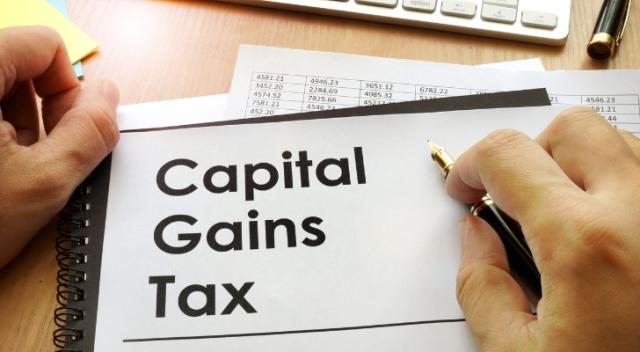How to Calculate Capital Gain on Rental Property Sale
Understanding how to calculate capital gains on sale of rental property is key to understanding overall profit on sale but also your liabilities.
Even so, it can be bewildering for many.
Details like purchase prices and improvements often lead to errors, causing uncertainty about taxes and hindering confident real estate decisions, and the fear of errors curtails financial growth and portfolio development.
However, it doesn’t have to be this way, especially if you walk through our guide below…
Table of Contents
How to a Calculate Capital Gain on a Rental Property
To calculate the capital gain on a rental property, begin with the original purchase price, add any extra expenses (such as renovation costs or improvements), and then deduct this combined amount from the selling price and the cost of the sale (commissions, fees, etc.).
Here’s a simple formula:
Capital gain = (Purchase price + Improvements) – Selling price – Cost of Sale
1. Determine the Original Purchase Price
This is simply the original purchase price you paid for the property — so, if the contracted list price was $300,000 at the time of purchase, it’s $300,000 for your capital gains tax calculation.
2. Add Additional Expenses
Include any additional expenses incurred during your ownership, such as:
- Renovation costs
- Repairs
- Improvements.
These costs increase the property’s adjusted basis.
3. Subtract depreciation
You now need to factor in the depreciated amount for that property over the time period between purchasing it and now selling it.
This will reduce the adjusted cost basis that capital gains tax will apply to.
4. Calculate the Adjusted Basis
Calculate the adjusted basis by taking the original purchase price, adding the the additional expenses, and subtracting the depreciation.
This adjusted basis represents the total amount of money you’ve invested in the property, but also taking into account a fair depreciated amount over time with the formula being:
Adjusted cost basis = original purchase price + expenses – depreciation.
5. Determine the Selling Price
For the selling price, it’s possible you could deduct the following fees, which will reduce your capital gains tax since they will reduce the net selling proceeds:
- Legal and professional fees relating to the sale (incl. real estate commission)
- Property taxes relating to the sale
- Home warranty costs
- Title insurance policies
- Marketing costs
- Transfer taxes (in California, this is $1.10 per $1,000 at the time of writing)
For example, if your listed selling price was $300,000 but the selling costs totaling from the above list was $5,000, the net selling price you’d use for your capital gains tax calculation would be $300,000 – $5,000 = $295,000.
6. Calculate Capital Gain
Subtract the adjusted basis (Step 4) from the selling price (Step 5). The result is your capital gain from the rental property, which is as follows as a formula:
Capital gain = Listed selling price – related selling costs – original purchase price + additional expenses – depreciation
Note: If the selling price is higher than the adjusted basis, you have a capital gain. If it’s lower, you might incur a loss on sale of a rental property.
7. Report the Sale
We have more detailed information on our our article outlining how to report the sale of rental property, but the basics are to complete Schedule D of Form 1040 in the year of the sale to document the transaction. If you’ve previously claimed depreciation on the property, file Form 4797 (Sales of Business Property) as well. Fulfilling these reporting obligations is crucial for complying with California state tax regulations, ensuring a smooth and legal property sale process.
Example of How to Calculate Capital Gains on Rental Property
For this illustration, imagine an investor who purchased a commercial office building in downtown Los Angeles five years ago for $3.5 million and invested an additional $200,000 in renovations and improvements.
To calculate capital gains tax on an investment property sold for $5 million (after selling fees) in 2024, the investor would follow these steps:
1. Calculate the Basis:
Original Purchase Price: $3.5 million
Capital Improvements: $200,000
Total Basis: $3.7 million
2. Adjust for Depreciation
Commercial real estate can be depreciated over 39 years straight-line. Assuming the building’s original cost (excluding land) was $3 million (including capital improvements), the depreciation taken over five years would be approximately $384,615 ($3,000,000 / 39 years = $76,923 x 5 years).
3. Adjusted Basis
Adjust the basis by subtracting the depreciation from the total cost basis: $3,700,000 – $384,615 = $3,315,385 adjusted basis.
4. Calculate Capital Gain
Capital Gain = Selling Price – Adjusted Basis
= $5,000,000 – $3,315,385
= $1,684,615 capital gain.
5. Determine Depreciation Recapture Tax
Depreciation recapture is taxed at a flat rate of 25%. For the depreciation taken ($384,615), the tax due on depreciation recapture would be $96,153.75.
6. Calculate Capital Gains Tax
The remaining capital gain ($1,684,615 – $384,615 = $1,300,000) then has capital gains taxed applied to it.
CGT applies at both a federal and a state level.
Federal CGT
From a federal perspective, there are different rates for short-term holds and long-term:
- Short term: Less than 1 year
- Long term: Greater than 1 year
Short-term rates are as follows for 2024:
| Rate | Single | Married Filing Jointly | Married Filing Separately | Head of Household |
| 10% | $0 – $11,000 | $0 – $22,000 | $0 – $11,000 | $0 – $15,700 |
| 12% | $11,001– $44,725 | $22,001– $89,450 | $11,001– $44,725 | $15,701– $59,850 |
| 22% | $44,726– $95,375 | $89,451– $190,750 | $44,726– $95,375 | $59,851– $95,350 |
| 24% | $95,376– $182,100 | $190,751– $364,200 | $95,376– $182,100 | $95,351– $182,100 |
| 32% | $182,101– $231,250 | $364,201– $462,500 | $182,101– $231,250 | $182,101– $231,250 |
| 35% | $231,251– $578,125 | $462,501– $693,750 | $231,251– $346,875 | $231,251– $578,100 |
| 37% | $578,125+ | $693,750+ | $346,875+ | $578,100+ |
For 2024, Long-term rates are:
| Rate | Single | Married Filing Jointly | Married Filing Separately | Head of Household |
| 0% | $0 – $44,625 | $0 – $89,250 | $0 – $44,625 | $0 – $59,750 |
| 15% | $44,626 – $492,300 | $89,251 – $553,850 | $44,626 – $276,900 | $59,751 – $523,050 |
| 20% | $492,300+ | $553,850+ | $276,900+ | $523,050+ |
So, in our working example, since the property was held for over 1 year, the long-term rates apply, and depending on the filing status of the individual, the rate would be:
20% x $1,300,000 = $260,000 since the gain is above the thresholds for all of the filing statuses.
California State CGT
In addition, we needed to apply the CGT rate in California.
Here, the tax brackets for capital gains mirror that of personal income, and vary depending on your filing status for 2024:
| Rate | Single | Married Filing Jointly | Married Filing Separately | Head of Household |
| 1% | $0 – $8,932 | $0 – $17,864 | $0 – $8,932 | $0 – $17,864 |
| 2% | $8,933 – $21,175 | $17,865 – $42,350 | $8,933 – $21,175 | $17,865 – $42,353 |
| 4% | $21,176 – $33,421 | $42,351 – $66,842 | $21,176 – $33,421 | $42,354 – $54,597 |
| 6% | $33,422 – $46,394 | $66,843 – $92,788 | $33,422 – $46,394 | $54,598 – $67,569 |
| 8% | $46,395 – $58,634 | $92,789 – $117,268 | $46,395 – $58,634 | $67,570 – $79,812 |
| 9.3% | $58,635 – $299,508 | $117,269 – $599,016 | $58,635 – $299,508 | $79,813 – $407,329 |
| 10.3% | $299,509 – $359,407 | $599,017 – $718,814 | $299,509 – $359,407 | $407,330 – $488,796 |
| 11.3% (plus 1% for income over $1,000,000) | $359,408 – $599,012 | $718,815 – $1,198,024 | $359,408 – $599,012 | $488,797 – $814,658 |
| 12.3% (plus 1% for income over $1,000,000) | $599,013+ | $1,198,025+ | $599,013+ | $814,659+ |
So, in our working example, the gain of $1,300,000 will be taxed at 12.3%, so:
State CGT = 12.3% x $1,300,000 = $159,900.
Combined federal and state CGT = $260,000 + $159,900 = $419,900 for 2024
7. Additional Taxes:
If the investor’s income falls above the thresholds for the Affordable Care Act (ACA) surtax on the total capital gain, then a further 3.8% on the gain might apply.
In this example, the total capital gains tax liability for the investor would be the sum of:
- Depreciation recapture tax: $96,153.75
- Federal long-term capital gains tax: $260,000
- California state capital gains tax: $159,900
- TOTAL = 513, 053.75
Keep in mind that tax laws, especially when calculating capital gains tax on an investment property, can change, and everyone’s situation is different. Consulting with a tax professional is essential for accurate calculations and advice tailored to your specific circumstances.
Key Takeaways on Calculating Capital Gains on Rental Property
Understanding how to figure out capital gains on the sale of a rental property is vital for investors.
Here are the key takeaways to keep in mind:
- Basis Calculation: Start with the original purchase price and add any additional expenses like improvements to determine the basis of the property. This forms the foundation for calculating capital gains.
- Depreciation Adjustment: If you’ve claimed depreciation on the property, subtract it from the adjusted basis. Depreciation affects your capital gains tax liability upon selling your investment property.
- Capital Gain Calculation: Subtract the adjusted basis from the selling price to calculate the capital gain. This figure represents the profit made from the sale of the property.
- Tax Implications: Understand the tax implications of capital gains. Depreciation recapture is taxed at a different rate than the remaining capital gain, which is subject to long-term capital gains tax rates, and both federal and state taxes apply.
- Consultation is Crucial: Given the complexity of tax laws and individual variations in investment scenarios, consulting a tax professional is crucial. They can provide accurate calculations and personalized advice tailored to your specific situation.
By grasping these key points, investors can navigate the process of calculating capital gains on rental properties more effectively, ensuring they make informed financial decisions in the real estate market.
Additional reading: when to sell a rental property









